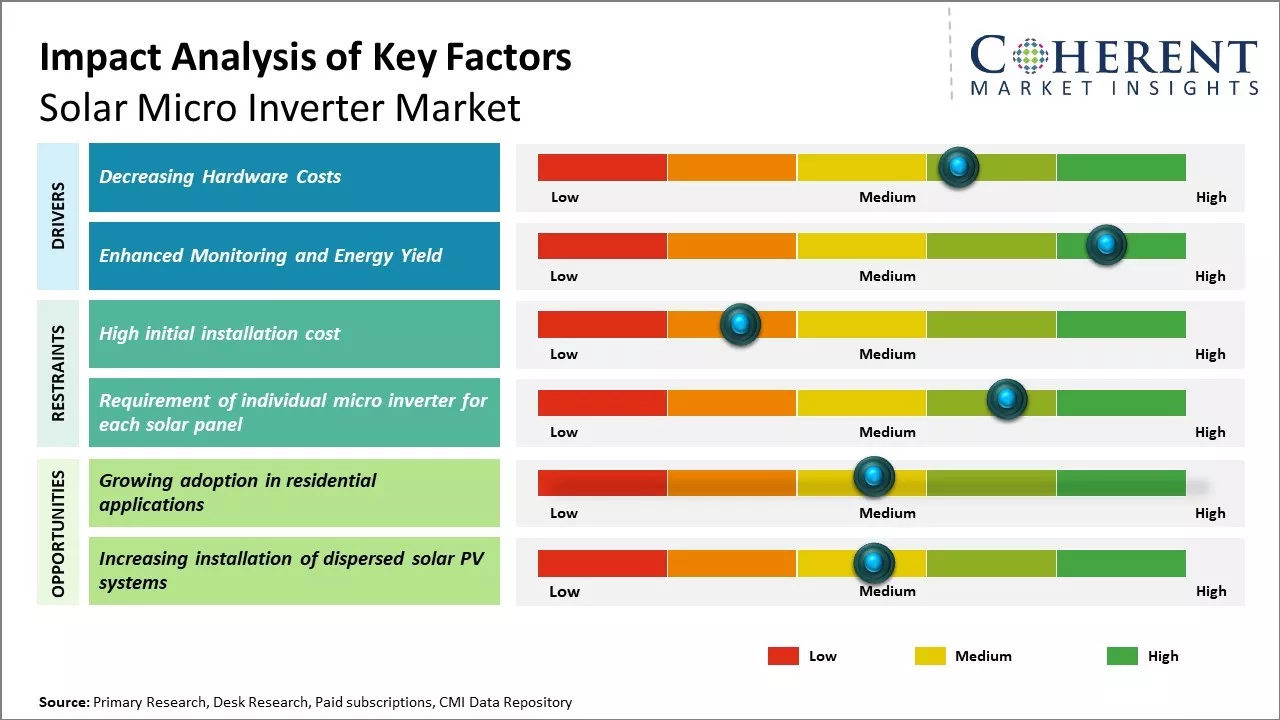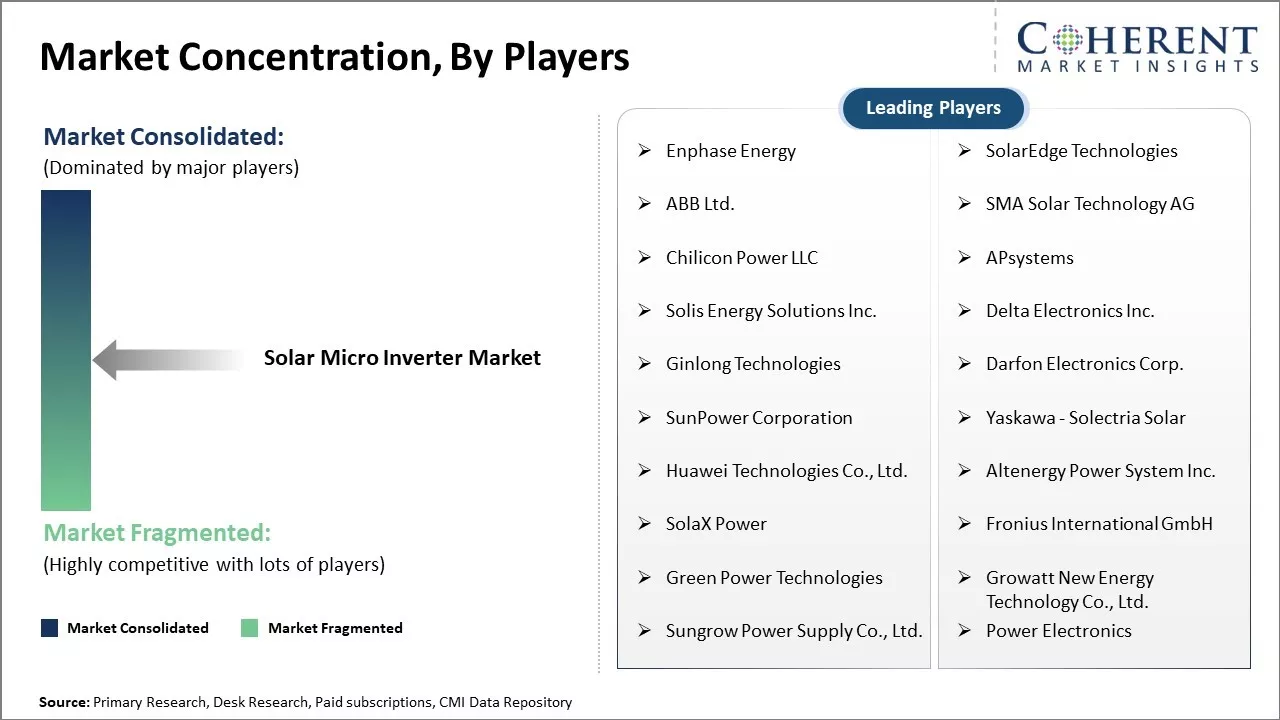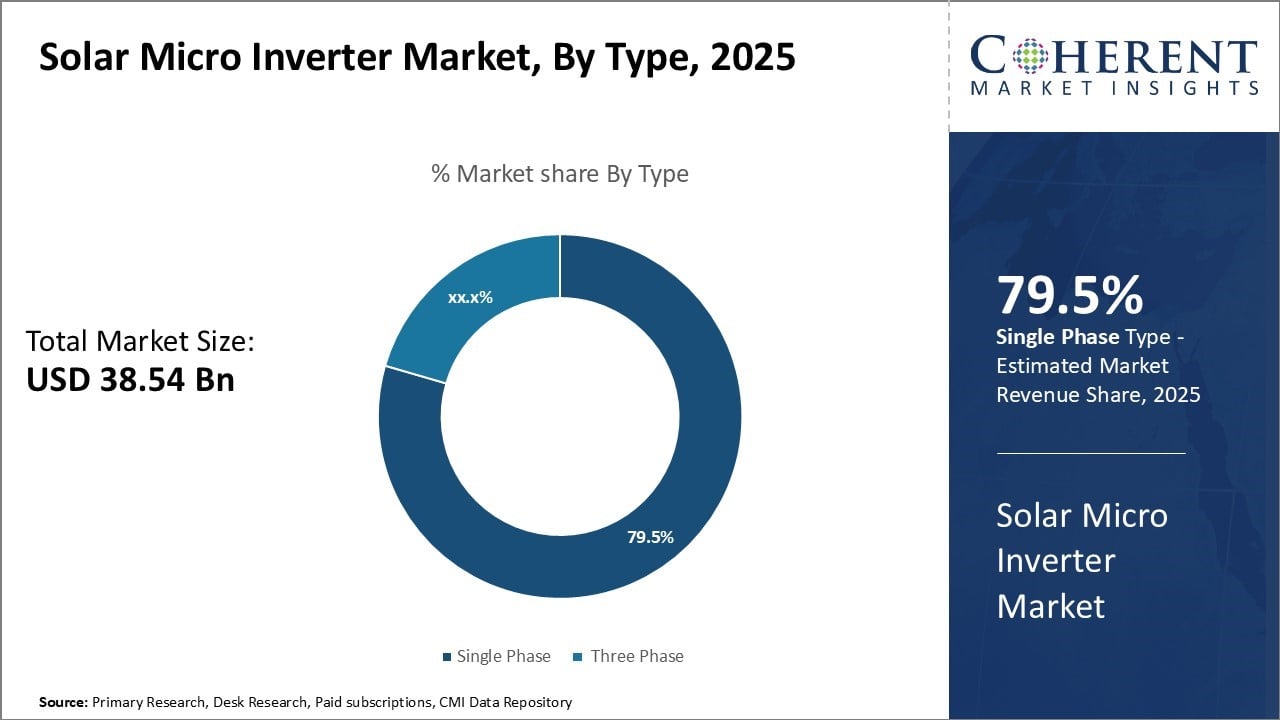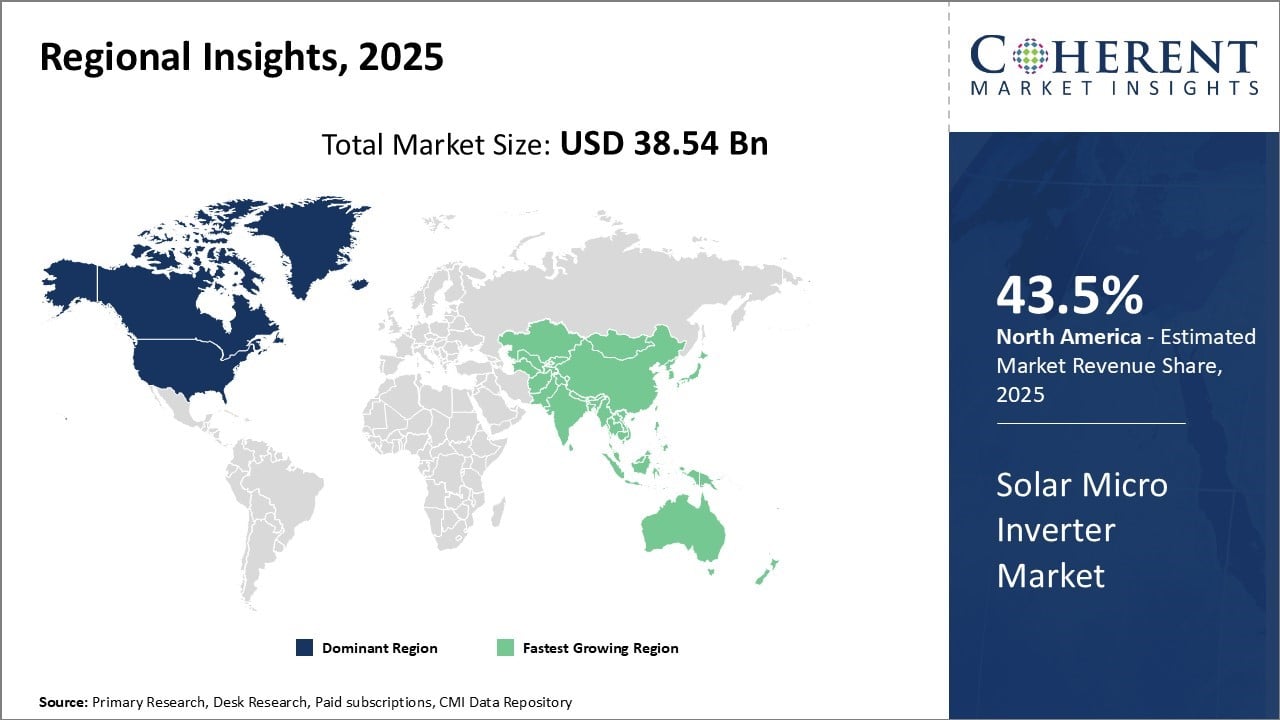The Solar Micro Inverter Market is estimated to be valued at USD 38.54 Bn in 2025 and is expected to reach USD 137.37 Bn by 2032, growing at a compound annual growth rate (CAGR) of 19.9% from 2025 to 2032.

To learn more about this report, Download Free Sample
Micro inverters allow the optimal performance of each solar module individually to boost the overall system efficiency. Their use has increased the adoption of solar energy across the residential and commercial sectors. The solar micro inverter market is expected to witness significant growth over the forecast period. Stringent regulations regarding carbon footprint reduction and growing emphasis on renewable sources of energy are expected to drive the demand for solar micro inverter. Moreover, the trend towards decentralized and distributed solar generation coupled with technical benefits of micro inverters such as module level monitoring, optimal energy harvesting, and ease of maintenance are anticipated to provide opportunities for market growth during the forecast period.
|
Event |
Description and Impact |
|
Geopolitical and Trade Dynamics |
|
|
Technological Advancements and Innovation |
|
|
Economic Policies and Incentives |
|
Uncover macros and micros vetted on 75+ parameters: Get instant access to report
In 2024, the global solar micro inverter market is expected to reach $2.8 billion. This market has a broad range of pricing from $80 - $400 per unit which is dictated by power ratings, brand status and level of features offered. Micro inverters are more expensive than traditional string inverters because they offer better performance, include module-level monitoring, and provide greater system flexibility. Key pricing drivers include regional cost factors as well as warranty duration (10-25 years), efficiency (between 94% and 97.5%), connectivity features and system performance benchmarks like inverter capacity (typically between 250W to 500W).
The tier premium leader Enphase Energy prices their IQ8 series between $185 -$220 per unit, offering advanced grid form capability, 25 year warranties, with voltages units costing them around the mid-range of $0.42-$0.65 per watt. SolarEdge’s power optimizers which are classified as hybrid solutions range from $45 to $85, however they require central inverters bringing the total system price to about $0.35-$0.50 per watt. APsystems and Hoymiles who fall into the mid-tier brands have their units priced between $95 and $165 bringing per watt pricing down to between $0.28 -$0.55 appealing to budget driven buyers who still want decent reliability along with good performance.
Budget/value offerings like TSUN target entry-level segments with prices around $75 to $95 per unit (~$0.21–$0.27 per watt), appealing primarily to price-sensitive markets.
Overall, growing scale, semiconductor innovations, and competitive positioning are expected to lower prices by 8– 10% annually over the next five years, further accelerating micro inverter adoption worldwide.
Enphase Energy, SMA Solar Technology, Darfon Electronics, and Hoymiles are some of the leading technology companies working on solar micro inverters and actively shaping the patent landscape. Between 2020 and 2024, more than 480 patents related to micro inverter technology were filed globally with a focus in the United States, China, and Germany. More recent filings center around features that allow smart grids and distributed energy resources to communicate bidirectionally.
Also, module level algorithms dealing with maximum power point tracking (MPPT) have been evolving which is beneficial for the system’s energy yield as well as efficiency. Furthermore, an increasing number of patents now concentrate on high-temperature conditions thermal management that improves performance and longevity of inverters.
There also appears to be trends emerging focusing on artificial intelligence (AI) or machine learning concerning predictive maintenance along with real-time system optimization while they are active. Innovations in devices associated with power semiconductors aim at increasing efficiency while reducing size as well as heat generation which is common with gallium nitride (GaN) or silicon carbide (SiC).
Shifting the patent scope from device structures towards compact smarter Inverters indicates their significance along modernized competition within industry backed up by protective laws on inventions emphasizes innovation focused around patented designs that preserve market opportunities alongside advancing technology within solar micro inverters.
The solar micro inverter market is undergoing a significant transformation fueled by cutting-edge power electronics and intelligent energy management innovations. The adoption of wide bandgap semiconductors such as silicon carbide (SiC) and gallium nitride (GaN) enables higher switching frequencies, enhanced thermal management, and more compact, efficient inverter designs.
Modern Maximum Power Point Tracking (MPPT) algorithms have evolved to incorporate machine learning, allowing real-time adaptation to environmental changes such as shading, temperature fluctuations, and seasonal variations. This results in optimized energy harvest and improved performance compared to conventional string inverter systems.
With the help of new communication technologies, like Power Line Communication (PLC), ZigBee, and WiFi, real-time diagnostics can now be done on a module level. AI cloud analytics not only anticipate maintenance but also fine-tune system parameters to elevate energy production alongside financial returns. Micro inverters can now actively assist the grid due to advanced grid integration capabilities such as voltage regulation and frequency response. Stricter anti-islanding protection strengthens the reliability of the system during grid disruptions.
Manufacturer innovations demonstrate these advancements: Enphase’s IQ8 series with grid-forming capabilities allowing operation during outages, SolarEdge’s HD-Wave improving efficiency through novel power conversion, and APsystems’ QS1 with integrated rapid shutdown and advanced thermal management offers industry-leading performance risks. Safeguards enhanced also included integrated arc fault AFCI circuit interrupters alongside rapid shut down systems that considerably lower fire hazards. Improved encapsulation protects sensitive components from harsh environmental conditions while supplementing stronger coatings and materials increases reliability.
Collectively, all these advances work with one another driving change within the solar industry; modern business models are made possible, higher solar penetration into the grid is encouraged, costs lowered due to automated manufacturing brought micro inverters to center stage as essential parts in smart distributed energy networks.

To learn more about this report, Download Free Sample
The expenses related to the hardware components of solar micro inverters have noticeably decreased over the last few years. Increased global demand for both residential and commercial solar PV installations has enabled manufacturers to achieve considerable economies of scale. This in turn has allowed them to streamline new materials processes and cut down on costs while enhancing R&D spending, leading to more efficient micro inverter designs with reduced material expenditure. Compared to string inverters, their semiconductor chips and Integrated Circuits (ICs) are portions of micro inverters that take up much smaller real estate proportionally, which also drives down costs. In addition, expensive innovations directed toward power conversion design have improved power densities by manifolds which translates directly into hardware cost reductions.
Recently developed high-efficiency power switching devices such as SiC MOSFETs or IGBTs along with advanced gate driver modules have maximized achievable outputs replacing older components. Because of this, manufacturers are able to increase efficiency as these newer parts reduce the necessary number of components per unit while still maintaining the same delivered power capacity.
Due to the sustained reduction in pricing over the last few years, solar installers and homeowners find microinverters much more affordable. Even in emerging solar economies that are price sensitive, microinverters are now an appealing option as their payback period has significantly improved.
Moreover, localized manufacturing, particularly in China and Southeast Asia, has bolstered supply availability, thus ensuring better value to end users passing on cost benefits realized through increased production scales. Overall, the steep decline seen in hardware costs is a primary factor strengthening the market competitiveness of solar micro inverters compared to traditional string inverters.
One of the benefits of micro inverters is that solar energy can be harvested from each solar PV module individually. The string and central inverters suffer the shortcoming that shaded or underperforming sections of strings cannot but carry portions to contribute their potential due to losses elsewhere. Micro inverters eliminate this problem because they monitor power conversion for each solar panel individually and therefore perform optimization separately for every panel. This enhances utilization of solar energy even with partial shade such as in rooftop systems.
Newer models with added features have also integrated advanced monitoring which provides additional value. Home and commercial building owners can track activity on all modules through mobile and web dashboards, thereby monitoring performance remotelycentered hou. The compiled production data per module enables proactive detection of faults or underperformance enabling prompt response by system admins to resolve problems long before their expected time without automation leading to loss prevention.
However, the solar micro inverter market also presents several opportunities. Micro inverters can harvest up to 30% more energy from each solar panel compared to string inverters. This improves returns on investment.

To learn more about this report, Download Free Sample
The single phase segment contributes the highest share of 79.5% in 2025 to the solar micro inverter market owing to its convenience and cost-effectiveness. As most residential solar systems use single phase electricity, these micro inverters are well-suited for homeowners looking to install rooftop panels. They have simple installations that do not require expensive rewiring of electrical panels. Homeowners receive a plug-and-play solution without much hassle.
Single phase micro inverters are also very cost-effective compared to larger multi-phase systems. They are much smaller and cheaper to manufacture while still delivering optimal power harvesting capabilities on a per panel basis. For solar installers, single phase micro inverters mean lower equipment and labor costs when deploying systems on residential rooftops. Their distributed architecture also enhances design flexibility to fully utilize available roof space.
With rising solar adoption among households, the single phase segment is expected to further cement its leading position. As technology improves energy yields and lifetimes increase, these micro inverters will see strong demand for their user-friendly and affordable attributes. Their decentralized approach that works with any roof layout also makes them very appealing for residential prosumers.
The hardware component contributes the highest share of 45.5% in 2025 among different micro inverter offerings due to being the core technological component that converts direct current from solar panels into alternating current usable by homes. These inverters are sophisticated electrical devices equipped with power transistors, switching components, capacitors and cooling mechanisms. They require precision engineering to reliably handle high voltage DC electricity from panels.
Despite software and service opportunities emerging, hardware revenues will remain robust given micro inverters' capital-intensive nature. Periodic hardware replacements will also boost sales over time. Manufacturers continue making hardware advances such as boosting power density within compact footprints, increasing energy yields, improving maximum power point tracking, and extending operational lifetimes above 25 years. These innovations attract more homeowners and keep hardware dominant within micro inverter offerings.
As hardware brings critical capacity and performance advantages over older technologies, suppliers prioritize new product development, and custom engineering support here. Robust hardware sales therefore drive reinvestments and further progress for the entire micro inverter industry.
Within micro inverter power ratings, the above 500W segment contributes the highest share of 39.5% in 2025 owing to more opportunities in commercial and multi-megawatt utility scale applications. Micro inverters with power outputs above 500W can efficiently handle larger 300-400W solar panels commonly used in non-residential projects. Their scalability alleviates earlier constraints and allows harnessing higher voltages compatible with broader system sizes.
Larger power capacities boost the technical potential for micro inverters. System integrators are adopting above 500W models to design solar Photo Voltaic PV plants rated over 1MW. Their modular flexibility streamlines assembly across vast commercial rooftops and ground mounts. Manufacturers also customize these high-power micro inverters suited for specialized uses like solar carports and solar trees.
As renewable energy portfolios of utilities expand, harnessing high power micro inverters becomes attractive to maximize returns from large vacant lands. Several pilot projects tie micros above 500W capacity with energy storage to evaluate performance managing intermittent solar generation. Such innovative deployments lay the foundation for broader grid services and renewables integration going forward. Overall, their greater scaling ability drives higher adoption within growing utility applications.
The residential segment has remained the largest application area for solar micro inverters over the past few years with 62.5% market share in 2025 owing to a rising number of homeowners opting for rooftop solar installations. Solar micro inverters are commonly used in residential solar photovoltaic systems as they offer several benefits over traditional string inverters. Micro inverters work efficiently on a module level, maximizing the energy harvest of each solar panel.
This helps homeowners derive optimal power output from their solar arrays throughout the day, even if some panels are partially shaded. Additionally, micro inverters enhance solar panel level monitoring. Homeowners can monitor the performance of individual panels from their smartphones using plant monitoring apps. This level of module-level monitoring has helped address underlying issues and boost overall system efficiency for residential consumers.
The trend of residential solar installations is gaining momentum globally due to favorable net metering policies and subsidies offered by governments. An increasing number of households are investing in rooftop panels to reduce their electricity bills as well as contribute to clean energy generation. In certain regions, new residential buildings are even mandated to install a minimum solar capacity.
This growing emphasis on distributed solar energy at the residential level has fueled the adoption of micro inverters to optimize module performance. As more homeowners look to harvest solar power through rooftop panels, the residential category is expected to sustain its lead in the solar micro inverter market over the coming years.

To learn more about this report, Download Free Sample
North America is projected to lead the global solar micro inverter market with a substantial 43.5% revenue share in 2025, owing to its mature solar infrastructure, favorable regulatory landscape, and strong domestic manufacturing ecosystem. The region’s leadership is reinforced by extensive federal and state-level incentive programs such as the Investment Tax Credit (ITC) and net metering policies, which have stimulated widespread residential and commercial solar adoption.
The United States, in particular, plays a central role, hosting major industry players such as Enphase Energy, SolarEdge, and Altenergy Power Systems, which have established extensive production and R&D facilities within the country. This domestic manufacturing advantage has made the U.S. a cost-efficient and innovation-driven hub for solar micro inverter production.
States like California, Arizona, and Texas characterized by high solar irradiance have been pivotal in accelerating market penetration, driven by both policy support and favorable climatic conditions. Local contractor expertise and reliable after-sales support have also strengthened consumer trust in micro inverter technology, positioning North America at the forefront of the global market.
Asia Pacific is expected to be the fastest-growing region in the global solar micro inverter market from 2025 to 2032, fueled by a surge in rooftop solar installations and increasing interest in decentralized energy systems. China remains the largest market within the region, supported by its large-scale urban solar deployment and government-backed renewable energy targets.
Leading Chinese solar giants such as JinkoSolar, Trina Solar, and Canadian Solar have recently diversified into micro inverter manufacturing to offer integrated photovoltaic solutions. This vertical integration, along with significant investment in production capacity, is enabling rapid scalability and competitive pricing, both domestically and for export markets.
Beyond China, countries like India, Japan, South Korea, and Australia are showing robust growth trajectories. In India, frequent grid outages and strong rooftop solar policies under initiatives like the National Solar Mission have made micro inverters an attractive choice for both residential and commercial consumers. Likewise, in Japan and South Korea, high electricity costs and compact urban environments are encouraging adoption of high-efficiency solar technologies such as micro inverters.
The United States dominates the North American market, bolstered by its advanced solar infrastructure, robust policy incentives, and the presence of leading micro inverter manufacturers. High penetration in sunbelt states and growing demand for smart, reliable solar solutions continue to drive market growth across both residential and commercial segments.
China leads the Asia Pacific region with aggressive expansion in rooftop solar installations and government mandates supporting distributed energy generation. Domestic manufacturers are rapidly entering the micro inverter space, aiming to provide cost-effective, integrated solar-plus-storage solutions for both national and international markets.
India is emerging as a high-potential growth market due to strong government initiatives promoting distributed solar, such as subsidies, net metering, and rural electrification. With rising energy needs and unstable grid conditions, micro inverters are increasingly preferred for ensuring greater energy independence and system reliability.
| Report Coverage | Details | ||
|---|---|---|---|
| Base Year: | 2024 | Market Size in 2025: | USD 38.54 Bn |
| Historical Data for: | 2020 To 2024 | Forecast Period: | 2025 To 2032 |
| Forecast Period 2025 to 2032 CAGR: | 19.9% | 2032 Value Projection: | USD 137.37 Bn |
| Geographies covered: |
|
||
| Segments covered: |
|
||
| Companies covered: |
Enphase Energy , SolarEdge Technologies , ABB Ltd. , SMA Solar Technology AG , Chilicon Power LLC , APsystems , Solis Energy Solutions Inc. , Delta Electronics Inc. , Ginlong Technologies , Darfon Electronics Corp. , SunPower Corporation , Yaskawa - Solectria Solar , Huawei Technologies Co., Ltd. , Altenergy Power System Inc. , SolaX Power , Fronius International GmbH , Green Power Technologies , Growatt New Energy Technology Co., Ltd. , Sungrow Power Supply Co., Ltd. , and Power Electronics |
||
| Growth Drivers: |
|
||
| Restraints & Challenges: |
|
||
Uncover macros and micros vetted on 75+ parameters: Get instant access to report
*Definition: The solar micro inverter market consists of micro inverters that are used in solar photovoltaic systems, allowing each individual solar panel to be connected to an inverter to convert the direct current (DC) power generated into alternative current (AC) power that can be used in homes and businesses or fed into the electrical grid. Micro inverters maximize solar power harvesting by enabling underperforming panels to be bypassed, reducing equipment costs, and installation complexities compared to traditional string.
Share
Share
About Author
As an accomplished Senior Consultant with 7+ years of experience, Pooja Tayade has a proven track record in devising and implementing data and strategy consulting across various industries. She specializes in market research, competitive analysis, primary insights, and market estimation. She excels in strategic advisory, delivering data-driven insights to help clients navigate market complexities, optimize entry strategies, and achieve sustainable growth.
Missing comfort of reading report in your local language? Find your preferred language :
Transform your Strategy with Exclusive Trending Reports :
Frequently Asked Questions
Joining thousands of companies around the world committed to making the Excellent Business Solutions.
View All Our Clients